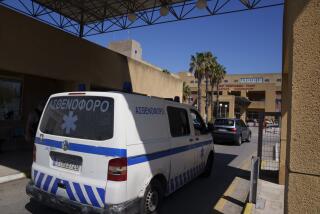Tourist Boom, Lack of Funds Cited : Bronze-Age Greek City May Stay Buried
- Share via
IALYSOS, Greece — A Bronze Age city lies beneath this sprawling seaside village on the resort island of Rhodes, but authorities say it may never be completely unearthed.
A flourishing tourist industry has boosted property values, and the Culture Ministry says it doesn’t have the money to expropriate the land for a full-scale excavation of the 3,500-year-old ruins.
“Ialysos is uniquely important in Aegean prehistory,” Toula Markettou, the government archeologist in charge of the site, said.
“It’s one of the biggest sites dating from the Late Bronze Age (1600 BC to 1100 BC). And it’s immensely frustrating not to be able to uncover it properly,” she said.
Minoan Culture
Historians believe that around 1800 BC, the Minoans of Crete exported their sophisticated culture 150 miles across the Aegean Sea to Rhodes.
The Minoan civilization is named after legendary King Minos who imprisoned the Minotaur, a mythical mixture of man and bull, in a labyrinth beneath his palace at Knossos in Crete.
Bronze Age Ialysos had ties with another Minoan-influenced town on the nearby island of Cos and similar settlements on Turkey’s Aegean coast.
Archeologists estimate that the ruins of ancient Ialysos can be found underneath an area of about 32 acres. Currently, buildings cover about 10% of that area.
Ban on Construction
Conservationists on Rhodes propose that half the area be declared an archeological zone and new construction be banned.
“When such important antiquities are found, local authorities should rescind building permits, but they don’t,” Nikolaos Tsikkis, the village president said. “They haven’t accepted that a Minoan city would be a major tourist attraction.”
Construction permits are issued by the island’s building office which is part of the provincial administration for the Dedecanese Islands.
New construction has become increasingly profitable because of the island’s flourishing tourist industry, and villagers made prosperous by the boom have been building luxury apartment blocks on their olive groves.
First Glimpse in 1980
More than 1 million people visit Rhodes every year and leave behind more than $300 million in foreign currency. The island in the southeastern Aegean Sea has an international airport close to Ialysos and scores of first-class hotels.
The villagers caught a first glimpse of the treasures underneath their soil in 1980 when construction workers digging foundations unearthed ancient remains.
Archeologists staged rescue digs at seven construction sites. Markettou said that at one site, they found a Minoan-style mansion with a spacious partitioned living room and fragments of carved stone lamps.
On other lots, archeologists found vividly painted fresco fragments in red, blue and yellow and three delicately modeled bronze figures, probably stemming from a Minoan shrine, she said.
Density of Occupation
Markettou said other finds indicate that some Bronze Age inhabitants settled outside Ialysos on the fertile coastal plain.
“Recent pottery finds from seven other nearby coastal locations show a density of Minoan-style occupation of Rhodes we’d never suspected,” she said. “But it’s not clear if there was an official Minoan colony here or simply a very considerable cultural influence.”
Parts of the excavation sites were covered by a thick layer of white volcanic ash that fell on Rhodes when the volcanic island of Santorini, 125 miles to the west, erupted in the 16th Century BC.
More to Read
Sign up for Essential California
The most important California stories and recommendations in your inbox every morning.
You may occasionally receive promotional content from the Los Angeles Times.











